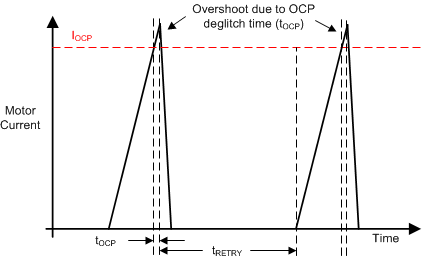SLVSFZ7 November 2021 DRV8231
PRODUCTION DATA
- 1 Features
- 2 Applications
- 3 Description
- 4 Revision History
- 5 Device Comparison
- 6 Pin Configuration and Functions
- 7 Specifications
- 8 Detailed Description
- 9 Application and Implementation
- 10Power Supply Recommendations
- 11Layout
- 12Device and Documentation Support
- 13Mechanical, Packaging, and Orderable Information
Package Options
Mechanical Data (Package|Pins)
Thermal pad, mechanical data (Package|Pins)
Orderable Information
8.4.3.1 Overcurrent Protection (OCP)
An analog current limit circuit on each FET limits the current through the FET by limiting the gate drive internally. If this analog current limit persists for longer than the OCP deglitch time (tOCP), all FETs in the H-bridge will disable. The driver re-enables after the OCP retry period (tRETRY) has passed. If the fault condition is still present, the cycle repeats as shown in Figure 8-4.
 Figure 8-4 OCP Operation
Figure 8-4 OCP OperationOvercurrent conditions are detected independently on both high- and low-side FETs. This means that a short to ground, supply, or across the motor winding will all result in an overcurrent shutdown. The ISEN pin also integrates a separate overcurrent trip threshold specified by VOCP_ISEN for additional protection when the VM voltage is low or the RSENSE resistance on the ISEN pin is high.